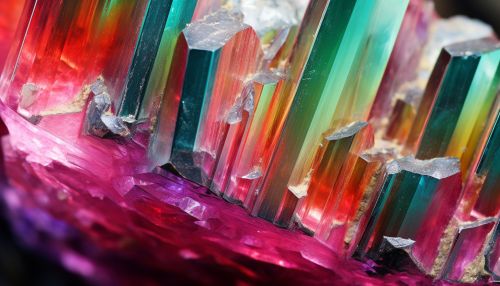Tourmaline
Introduction
Tourmaline is a crystalline boron silicate mineral compounded with elements such as aluminium, iron, magnesium, sodium, lithium, or potassium. Tourmaline is classified as a semi-precious stone and the gem comes in a wide variety of colors.
Etymology
The name comes from the Sinhalese word "turmali" (තුරමලි), which was the name given in Sri Lanka to all colored gemstones. The name tourmaline is derived from this term.
History
Tourmaline was first discovered by Dutch traders off the West Coast of Italy in the late 1600's or early 1700's. The Dutch traders brought the multicolored stones back to Europe, where they were used to make jewelry.
Chemical Composition
Tourmaline is a complex silicate of boron and aluminum, containing a variety of metal ions. Its general formula is XY3Al6(BO3)3Si6O18(OH,F)4, where X is usually Na or Ca, and Y is usually Al, Li, or Fe^2+. The complexity of the formula is due to the presence of various metal ions, which can be partially replaced by one another.
Physical Properties
Tourmaline crystals are elongated and three-sided, usually exhibiting striations parallel to their length. They can be colorless, but are typically very colorful, often exhibiting multiple colors in one specimen. The color is often zoned, with different colors in the axial and equatorial regions. Tourmaline has a hardness of 7-7.5 on the Mohs scale, a vitreous luster, and a specific gravity of 3.06.
Varieties and Colors
Tourmaline exhibits a wide range of colors, which are due to the presence of various metal ions. Some of the more well-known varieties include:
- Elbaite: This is the most colorful variety of tourmaline, and is the type most often used as a gemstone. It can be green, red, pink, blue, or colorless.
- Schorl: This is the most common variety of tourmaline, and is typically black or dark blue.
- Dravite: This variety is typically brown.
- Liddicoatite: This variety is typically pink, but can also be green or blue.
- Rubellite: This is a particularly beautiful variety of tourmaline, which is pink to red in color.
- Indicolite: This is a blue variety of tourmaline.
- Verdelite: This is a green variety of tourmaline.
- Watermelon tourmaline: This variety is pink in the center and green around the outside, resembling a slice of watermelon.
Occurrence and Mining
Tourmaline is found in many locations around the world. Some of the most notable sources include Brazil, Afghanistan, East Africa, and the United States. Tourmaline is mined in a variety of ways, depending on the nature of the deposit. It can be found in primary hard rock deposits, but it can also be found in secondary alluvial deposits where the weathering of the original rock has released the mineral and the action of the water has concentrated it in placer deposits.
Uses
Tourmaline has a variety of uses. The most common use is as a gemstone in jewelry. Due to its wide range of colors and its hardness, it is a popular choice for rings, necklaces, and other types of jewelry. In addition to its use as a gemstone, tourmaline is also used in pressure gauges due to its piezoelectric properties. When a voltage is applied to a tourmaline crystal, it changes shape, and this property can be used to measure pressure.


